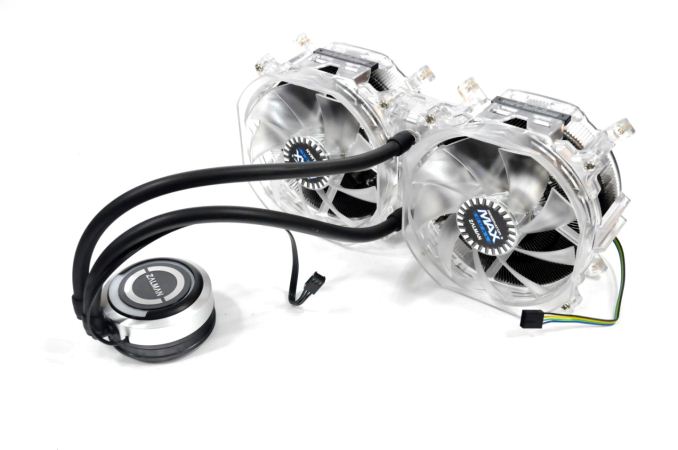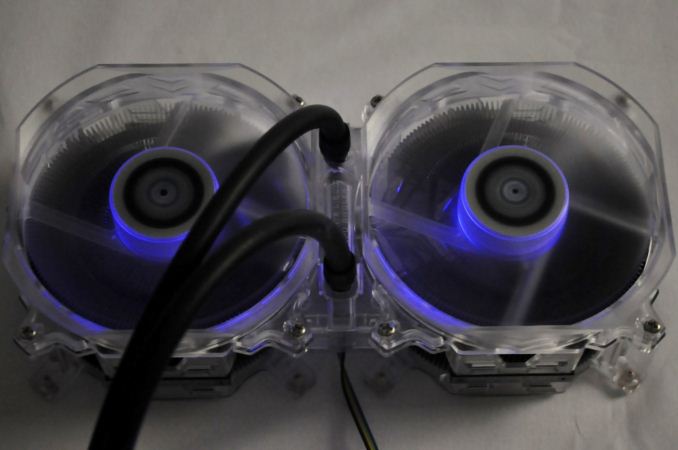Zalman Reserator 3 Max Dual CPU Cooler Review
by E. Fylladitakis on August 19, 2014 6:00 PM ESTConclusion
The Reserator 3 Max Dual is Zalman's trump card in the field of all-in-one liquid coolers and currently the most advanced such cooler that they offer. After they discontinued the Reserator 1 V2, it also is their most expensive liquid cooler, currently retailing for $140 incl. shipping at the time of this review. With the exception of the Enermax kits, which are unavailable in the US and importing them raises their cost dramatically, this makes the Reserator 3 Max Dual the most expensive all-in-one liquid cooler that we have tested to this date, regardless of size and features.
Zalman's Reserator 3 Max Dual certainly has a very long list of positive aspects. To begin with, it sports an impressive appearance that will easily stand out, without being extravagant or overly aggressive. It is very well made, using high quality materials and is free of imperfections. The PWM controlled fans are very handy to have, as their speed can be controlled by the motherboard, essentially emulating a typical CPU cooler and eliminating the need for external speed controllers and unnecessary cable clutter. If quality and appearance are what drives you, the Reserator 3 Max Dual will not be a disappointment.
On the other hand, the Reserator 3 Max Dual is far from flawless. The fancy-looking radiator is bulky and may easily create compatibility problems. Even with the supplied offset installation brackets, the case needs to be wide enough and you might lose a small portion of the radiator's area if the case does not have 140 mm fan openings. Moreover, although it sounds silly and unimportant, the decals on the sides of the radiator are upside down and that will look bad from a windowed side panel of a well-designed system. (Hopefully this is something that Zalman has fixed in their assembly process.) But ultimately, it's the performance of the Reserator 3 Max Dual cooler that confounds us the most.
Every all-in-one cooler that we have ever tested has a thermal resistance that either remains nearly constant or improves slightly as the load increases. Ideally, the thermal resistance of the cooler should be constant, but there are many factors at play in a complex multi-liquid system such as this. However, the thermal resistance of the Reserator 3 Max Dual increases alongside the load, which is inexplicable with what we know about this cooler.
Copper tends to have a thermal conductance that decreases faster than that of aluminum as the temperature rises, but the temperatures that we deal with are low and the change seems rather abrupt, therefore this is not very likely. Although we cannot fully explain why, it seems that the Reserator 3 Max Dual cannot dissipate high quantities of thermal energy quickly enough. This makes it the perfect cooler for the newest generation of processors but, at the same time, a bad idea for anyone who plans to use an energy-hungry CPU (e.g. extreme overclocking).
Our expectations were much higher from a product that is being advertised as the "ultimate CPU cooler". Assuming that the majority of enthusiasts that will buy such a cooling solution will also overclock their systems, we can only recommend the Reserator 3 Max Dual to those that will be using Haswell core processors, as they have very low energy requirements. If you expect the thermal power of your CPU to exceed 120 Watts when stressed, then another product will most likely be both cheaper and more effective.












52 Comments
View All Comments
mickulty - Wednesday, August 20, 2014 - link
"Although we cannot fully explain why, it seems that the Reserator 3 Max Dual cannot dissipate high quantities of thermal energy quickly enough."Could it be something to do with the overlapping cooling path?
E.Fyll - Wednesday, August 20, 2014 - link
Although I cannot really calculate it, I believe that the surface of the pipes is simply much smaller than the surface of a classic two-pass radiator. Therefore, even though it can dissipate heat very quickly via its sizable fin area, the surface between the array and the tubing is not sufficient to maintain a very large energy transfer.This simply is an assumption on my part and is not based on any form of evidence.